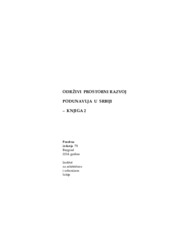Приказ основних података о документу
Ljudski (humani) resursi u Podunavlju u Srbiji
Human resources in Danube Region in Serbia
| dc.creator | Jokić, Vesna | |
| dc.date.accessioned | 2023-02-27T11:25:20Z | |
| dc.date.available | 2023-02-27T11:25:20Z | |
| dc.date.issued | 2014 | |
| dc.identifier.isbn | 978-86-80329-79-6 | |
| dc.identifier.uri | http://raumplan.iaus.ac.rs/handle/123456789/728 | |
| dc.description.abstract | Apstrakt: Ljudski resursi predstavljaju osnovu ekonomskog i socijalnog razvoja. Važna komponenta ljudskog razvoja su demografske resursi, koji uključuju opšte kvalitativne i kvantitativne karakteristike stanovništva. Demografski razvoj je jedan od glavnih izazova u ostvarivanju održivog/uravnoteženog razvoja, posebno sa stanovišta buduće organizacije društva, raspoloživih resursa radne snage, socijalne i teritorijalne kohezije i opšteg ekonomskog i socijalnog napretka zajednice. Istovremeno, koncept održivog razvoja podrazumeva postojanje potrebnog stepena demografske stabilnosti i uravnoteženosti funkcionalnih kontingenata u društvenoj zajednici i njenim regionalnim područjima. Ovaj rad daje pregled demografskih promena u periodu od 1948 do 2011. godine i karakteristike ljudskih resursa u Podunavlju u Srbiji. Analizirani su odabrani demografski indikatori, a populacioni potencijali su iskazani indeksom demografskih resursa. | sr |
| dc.description.abstract | Abstract: Human resources are the basis of economic and social development. An important component of human development are demographic resources, which include the overall qualitative and quantitative characteristics of the population. The demographic development is also one of the main challenges in achieving sustainable/balanced development, particularly with regard to the future organization of society, the available labour resources, social and territorial cohesion and general economic and social progress of the community. At the same time, the concept of sustainable development implies the existence of the requisite level of demographic stability and balance of functional groups in the community and its regional areas. This paper makes an overview of demographic changes in the period from 1948 to 2011, and characteristics of the human resources in Danube Region in Serbia. The analysis is based on selected demographic indicators, population potential being represented by the demographic resources index. | sr |
| dc.language.iso | sr | sr |
| dc.publisher | Beograd : Institut za arhitekturu i urbanizam Srbije | sr |
| dc.relation | info:eu-repo/grantAgreement/MESTD/Technological Development (TD or TR)/36036/RS// | sr |
| dc.rights | openAccess | sr |
| dc.source | Održivi prostorni razvoj Podunavlja u Srbiji - Knjiga 2 | sr |
| dc.subject | ljudski resursi | sr |
| dc.subject | starosna struktura | sr |
| dc.subject | depopulacija | sr |
| dc.subject | socijalni razvoj | sr |
| dc.subject | human resources | sr |
| dc.subject | age structure | sr |
| dc.subject | depopulation | sr |
| dc.subject | social development | sr |
| dc.title | Ljudski (humani) resursi u Podunavlju u Srbiji | sr |
| dc.title | Human resources in Danube Region in Serbia | sr |
| dc.type | bookPart | sr |
| dc.rights.license | ARR | sr |
| dc.citation.issue | 73 | |
| dc.citation.spage | 201 | |
| dc.citation.epage | 218 | |
| dc.citation.rank | M45 | |
| dc.identifier.fulltext | http://raumplan.iaus.ac.rs/bitstream/id/3020/Vesna_2014_73.pdf | |
| dc.identifier.rcub | https://hdl.handle.net/21.15107/rcub_raumplan_728 | |
| dc.type.version | publishedVersion | sr |

